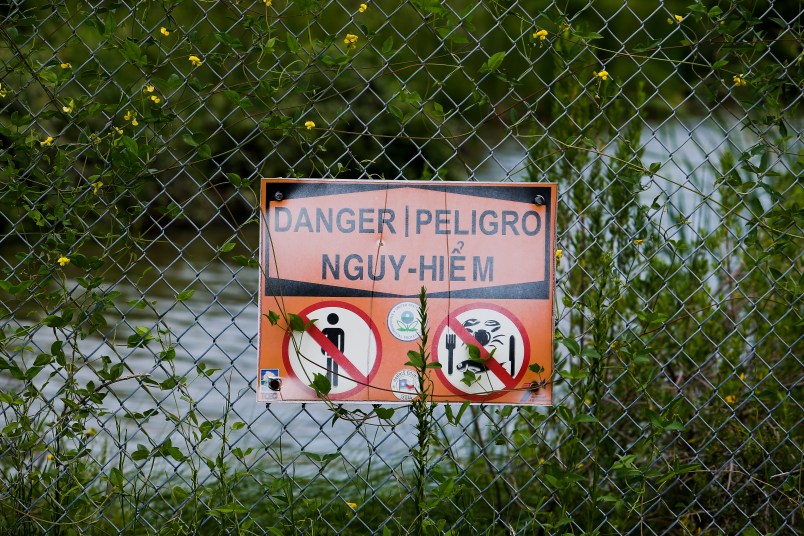After an Associated Press journalist reported this weekend that seven of Houston’s 41 Superfund sites were flooded with several feet of water, the Environmental Protection Agency (EPA) released a lengthy statement countering the claims and attacking the reporter.
The reporter, Michael Biesecker, visited seven of the 41 toxic waste sites impacted by Hurricane Harvey’s flooding in Houston and reported that all seven had been “inundated” by water.
The EPA had yet to visit any of the sites, according to the AP story, which noted a study completed under former President Barack Obama’s administration that concluded flooding at these sites could cause the spread of toxic materials.
The EPA responded with a statement calling the reporter lazy for “reporting from the comfort of Washington” even though Biesecker was in Houston and calling the story “incredibly misleading.”
The EPA also attacked Biesecker’s previous reporting and tried to debunk his story, saying the agency had viewed, but not visited, all the toxic waste sites through “aerial imaging.”
Read the full statement below:
Yesterday, the Associated Press’ Michael Biesecker wrote an incredibly misleading story about toxic land sites that are under water.
Despite reporting from the comfort of Washington, Biesecker had the audacity to imply that agencies aren’t being responsive to the devastating effects of Hurricane Harvey. Not only is this inaccurate, but it creates panic and politicizes the hard work of first responders who are actually in the affected area.
Here’s the truth: through aerial imaging, EPA has already conducted initial assessments at 41 Superfund sites – 28 of those sites show no damage, and 13 have experienced flooding. This was left out of the original story, along with the fact that EPA and state agencies worked with responsible parties to secure Superfund sites before the hurricane hit. Leaving out this critical information is misleading.
Administrator Pruitt already visited Southeast Texas and is in constant contact with local, state and county officials. And EPA, has a team of experts imbedded with other local, state and federal authorities, on the ground responding to Harvey – none of which Biesecker included in his story.
Unfortunately, the Associated Press’ Michael Biesecker has a history of not letting the facts get in the way of his story. Earlier this summer, he made-up a meeting that Administrator Pruitt had, and then deliberately discarded information that refuted his inaccurate story – ultimately prompting a nation-wide correction. Additionally, the Oklahoman took him to task for sensationalized reporting.
If you’re reporting on this misleading story then below is a statement from the EPA.
“Once again, in an attempt to mislead Americans, the Associated Press is cherry-picking facts, as EPA is monitoring Superfund sites around Houston and we have a team of experts on the ground working with our state and local counterparts responding to Hurricane Harvey. Anything to the contrary is yellow journalism.” – EPA Associate Administrator, Liz Bowman
The Hill reports EPA finds 13 Superfund sites possibly damaged after Harvey. “The Environmental Protection Agency (EPA) said Saturday that 13 Superfund sites have been flooded or could be facing damage as a result of Hurricane Harvey. The agency said that two of the sites, which are areas that are polluted with hazardous material and require extensive cleanup, had been inspected and do not require immediate cleanup. Eleven sites have proven to be inaccessible for response teams, however the agency said teams are in place to inspect the areas once flooding from the storm subsides. In total, the EPA said that it had conducted initial assessments at 41 Superfund sites in impacted areas using ‘aerial images’ and contact with with those responsible for regular cleanup activities.”
In June, the editorial board at the Oklahoman reminded their readers of the sensationalized reporting that comes from the Associated Press’ Michael Biesecker. “The disdain that some in the media have for President Trump and members of his administration is evident regularly. Recent coverage related to EPA administrator Scott Pruitt provides an example of interest to locals because of Pruitt’s Oklahoma ties. … An Associated Press story from Washington last week about emails Pruitt sent and received as attorney general did what it could to further establish Pruitt as a minion for the oil and gas industry — which environmentalists see as dead set on ruining the earth as we know it. The AP, a wire service used by media outlets around the world including The Oklahoman, said the emails ‘underscore just how closely’ Pruitt ‘coordinated with fossil fuel companies’ as Oklahoma’s AG, ‘a position in which he frequently sued to block federal efforts to curb planet-warming carbon emissions.’ That’s quite an opening paragraph. Pruitt didn’t just work with energy companies while attorney general — he worked ‘closely’ with ‘fossil fuel companies’ (the ultimate bogey men) to essentially keep global warming from abating. … The fact Pruitt regularly corresponded and dealt with energy industry officials as attorney general of a state where energy is the No. 1 industry should not be surprising nor should it, by itself, be considered nefarious.”







Not “protecting” much except the Trump administration I see.
Motherfuck the motherfucking motherfuckers installed by 45 at EPA
So they haven’t hired anybody at the EPA except an Attack Dog PR staff.
(Shakes head)
a/k/a Goebbels (R-OK)
Without getting into any of the specifics which I’m sure the journalist reported with all the accuracy he possessed at the time of his report, when has EPA ever issued such a hectoring bit of political cant prior to Pruitt’s appointment?